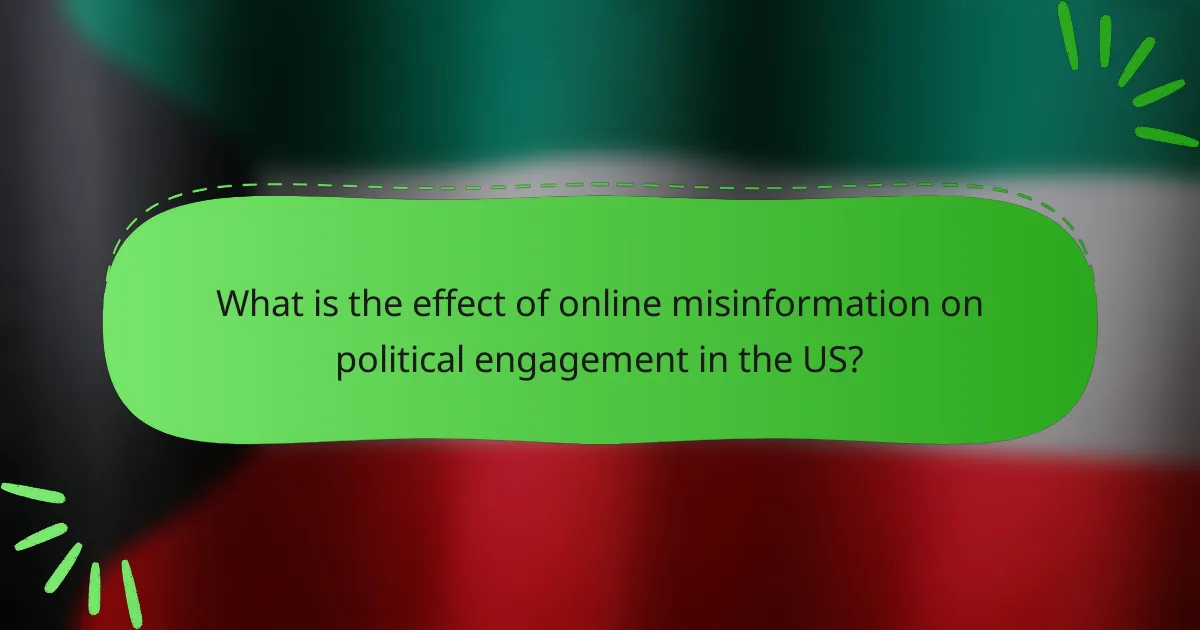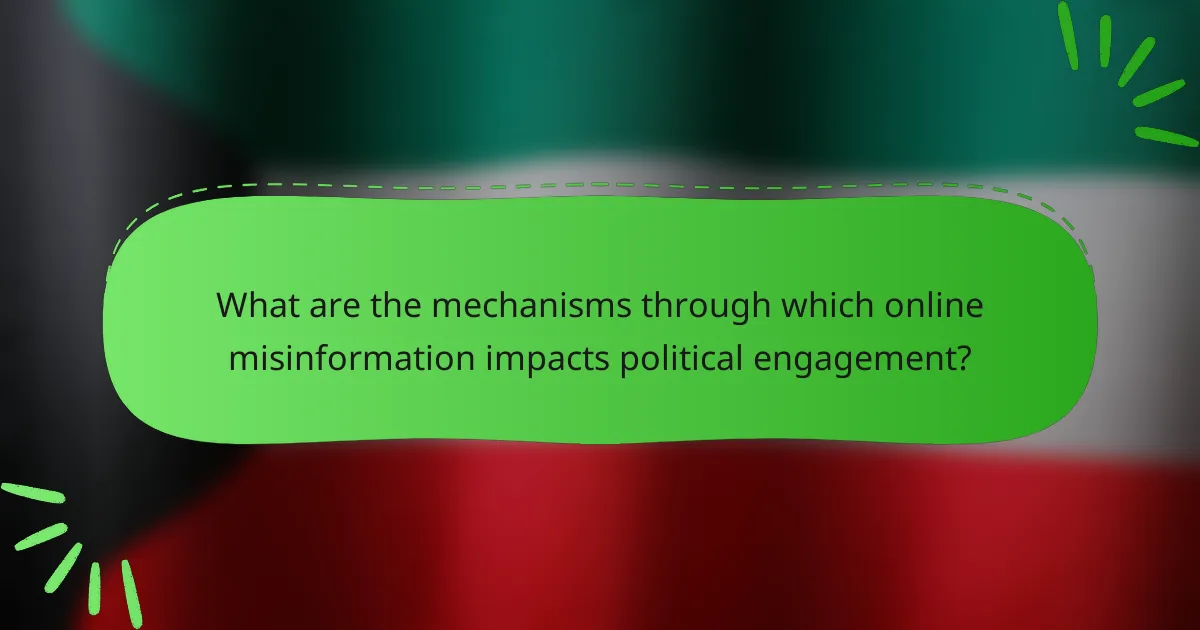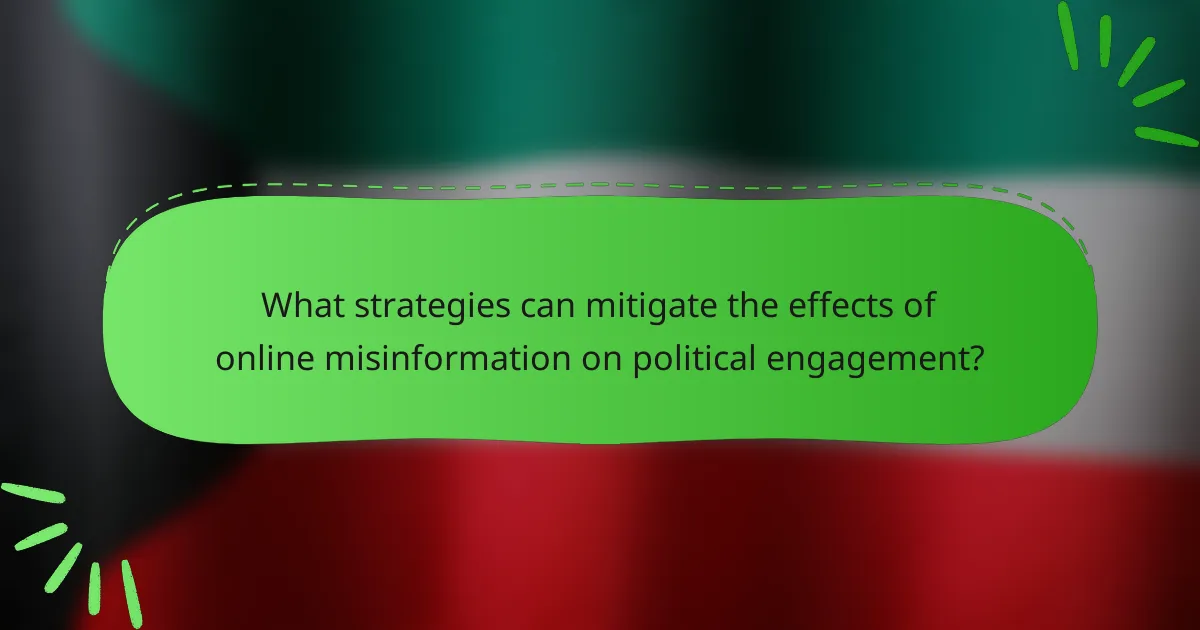Online misinformation significantly affects political engagement in the United States, leading to increased polarization and distorted perceptions of political issues. Research from the Pew Research Center indicates that a majority of Americans believe misinformation influences their political views, resulting in decreased trust in traditional media and lower voter turnout. The article explores the mechanisms by which misinformation suppresses civic participation, including its role in creating confusion about candidates and policies. It also discusses potential solutions, such as fact-checking initiatives, media literacy programs, and improved content moderation on social media platforms, aimed at mitigating the negative impacts of misinformation on democratic processes.

What is the effect of online misinformation on political engagement in the US?
Online misinformation negatively impacts political engagement in the US. It leads to increased polarization among citizens. Individuals exposed to misinformation often develop skewed perceptions of political issues. This can result in decreased trust in traditional media sources. Research indicates that misinformation can suppress voter turnout. A study by the Pew Research Center found that 64% of Americans believe misinformation affects their political views. Furthermore, misinformation can create confusion about candidates and policies. This confusion can deter informed discussions and civic participation.
How does online misinformation influence voter behavior?
Online misinformation significantly influences voter behavior by shaping perceptions and decision-making. It can lead to the spread of false narratives that misinform voters about candidates and policies. Research indicates that 70% of Americans encounter misinformation online, impacting their voting preferences. Misinformation can create polarization, as individuals gravitate towards content that aligns with their beliefs. This dynamic can suppress voter turnout or encourage voting for misrepresented candidates. Studies show that misinformation campaigns have been effective in swaying election outcomes, as seen in the 2016 U.S. Presidential Election. The pervasive nature of social media amplifies these effects, making misinformation a critical factor in contemporary political engagement.
What are the psychological effects of misinformation on voters?
Misinformation significantly impacts voters’ psychological states. It can lead to increased anxiety and confusion about political issues. Voters may experience cognitive dissonance when confronted with conflicting information. This dissonance can result in stress and frustration. Misinformation also fosters distrust in political institutions and media sources. A study by the Pew Research Center found that 64% of Americans believe misinformation has a negative impact on their understanding of political issues. Furthermore, exposure to misinformation can polarize voter opinions, making consensus more difficult. Overall, misinformation undermines informed decision-making among voters.
How does misinformation shape public perception of political issues?
Misinformation significantly shapes public perception of political issues. It distorts facts and creates confusion among voters. This leads to misguided beliefs and opinions. Research indicates that exposure to misinformation can alter individuals’ attitudes toward political topics. For example, a study by the Pew Research Center found that 64% of Americans believe fabricated news stories cause confusion about the basic facts of political issues. Furthermore, misinformation can reinforce existing biases. When individuals encounter misleading information that aligns with their views, it strengthens their stance. This cycle creates polarized perspectives on political matters. Ultimately, misinformation undermines informed decision-making in the democratic process.
Why is online misinformation a significant concern in the political landscape?
Online misinformation is a significant concern in the political landscape because it undermines democratic processes. Misinformation can distort public perception and influence voter behavior. A study by the Pew Research Center found that 64% of Americans believe fabricated news stories cause confusion about basic facts. Additionally, misinformation can lead to polarization, as individuals gravitate towards false narratives that align with their beliefs. This phenomenon can erode trust in institutions and media sources. Furthermore, social media platforms often amplify misinformation due to algorithms favoring sensational content. The consequences include decreased political engagement and increased societal division.
What role do social media platforms play in spreading misinformation?
Social media platforms significantly contribute to the spread of misinformation. They enable rapid sharing of content among users. This instant dissemination can amplify false narratives. Algorithms often prioritize engagement over accuracy. Consequently, sensational or misleading posts gain visibility. Research indicates that misinformation spreads six times faster than factual information on these platforms. A study by Vosoughi, Roy, and Aral in 2018 found that false news stories reach 1,500 people six times more quickly than true stories. This phenomenon can distort public perception and influence political engagement.
How does misinformation affect trust in political institutions?
Misinformation significantly undermines trust in political institutions. When citizens encounter false information, they become skeptical of the motives and actions of these institutions. Research indicates that consistent exposure to misleading narratives can lead to a decline in public confidence. A 2020 study by the Pew Research Center found that 64% of Americans believe misinformation has a negative impact on their trust in government. This erosion of trust can result in decreased political participation and engagement. Furthermore, misinformation can polarize public opinion, reinforcing divisions and complicating consensus-building. Ultimately, the cycle of misinformation creates a climate where trust in political institutions is severely compromised.

What are the mechanisms through which online misinformation impacts political engagement?
Online misinformation impacts political engagement through various mechanisms. It can distort perceptions of political issues. This distortion leads to misinformed voting decisions. Misinformation can also create polarization among voters. Polarization reduces constructive dialogue and increases hostility. Additionally, misinformation can undermine trust in institutions. A lack of trust decreases voter participation. Research indicates that exposure to misinformation correlates with lower civic engagement. Studies show that individuals exposed to false information are less likely to vote.
How do different types of misinformation affect political discourse?
Different types of misinformation significantly affect political discourse by shaping public perception and influencing voter behavior. Misinformation can create confusion about political issues, leading to polarized opinions. For example, false claims about candidates can damage reputations and alter electoral outcomes. Research indicates that misinformation spreads faster on social media, amplifying its impact. A study by Vosoughi et al. (2018) found that false news stories are 70% more likely to be retweeted than true stories. This rapid dissemination can result in widespread misconceptions among the electorate. Consequently, misinformation undermines trust in institutions and complicates informed decision-making.
What are the common forms of misinformation encountered online?
Common forms of misinformation encountered online include fake news, misleading headlines, and manipulated images. Fake news articles often present false information as factual reporting. Misleading headlines may exaggerate or misrepresent the content of an article to attract clicks. Manipulated images can alter the context or meaning of a visual, misleading viewers. Additionally, conspiracy theories spread unverified claims that can influence public perception. Social media platforms often amplify these forms of misinformation, making them more widespread. Research indicates that misinformation can significantly impact political engagement by shaping opinions and behaviors.
How does misinformation differ from disinformation in political contexts?
Misinformation refers to false or misleading information shared without malicious intent. Disinformation, on the other hand, is deliberately false information shared with the intent to deceive. In political contexts, misinformation can arise from misunderstandings or errors, while disinformation is often a strategic tool used to manipulate public opinion or undermine trust. A study by the Pew Research Center in 2020 found that 64% of Americans believe misinformation is a major problem in politics. This highlights the significant impact both types of information can have on political engagement and public perception.
What demographic factors influence susceptibility to online misinformation?
Age, education level, and political affiliation are key demographic factors influencing susceptibility to online misinformation. Younger individuals tend to be more susceptible due to less experience in evaluating online content. People with lower education levels may lack critical thinking skills necessary to discern credible sources. Additionally, individuals with strong partisan beliefs are more likely to accept misinformation that aligns with their views. Research shows that 70% of Americans aged 18-29 have encountered misleading information online. A study by the Pew Research Center indicates that 64% of those with lower educational attainment struggle to identify false news. Furthermore, partisan alignment can lead to biased information processing, as individuals favor information that supports their political identity.
How does age affect the perception of misinformation among voters?
Age significantly affects the perception of misinformation among voters. Younger voters tend to be more susceptible to misinformation due to their higher engagement with social media. Older voters often rely on traditional news sources, which may reduce their exposure to misleading information. A study by the Pew Research Center found that 64% of adults aged 18-29 encounter misinformation online, compared to 36% of those aged 50 and older. Additionally, cognitive biases associated with age can influence how information is processed. Older individuals may have established beliefs that make them less likely to accept new, misleading information. Conversely, younger voters may lack experience in discerning credible sources, leading to misinterpretation. Overall, age plays a crucial role in shaping how voters perceive and react to misinformation.
What role does political affiliation play in the acceptance of misinformation?
Political affiliation significantly influences the acceptance of misinformation. Individuals often align their beliefs with information that supports their political views. Research shows that partisanship can lead to biased processing of information. A study by Lewandowsky et al. (2012) found that individuals are more likely to accept misinformation that aligns with their political ideology. This tendency is driven by cognitive dissonance, where conflicting information is rejected. Additionally, social media algorithms amplify partisan content, further entrenching misinformation acceptance. The result is a polarized information environment, where political affiliation dictates trust in sources and narratives.

What strategies can mitigate the effects of online misinformation on political engagement?
Implementing fact-checking initiatives can mitigate the effects of online misinformation on political engagement. Fact-checking organizations verify claims made in political discourse. Research indicates that exposure to fact-checked information reduces belief in false claims. Promoting media literacy programs educates individuals on identifying misinformation. Studies show that media literacy improves critical thinking skills. Encouraging social media platforms to enhance content moderation can limit the spread of false information. Platforms that employ stricter guidelines have seen reduced misinformation rates. Collaborating with trusted community leaders to disseminate accurate information fosters trust and engagement. Evidence suggests that community-driven efforts increase public awareness of reliable sources.
How can individuals critically evaluate information sources?
Individuals can critically evaluate information sources by assessing their credibility, relevance, and accuracy. First, they should check the author’s qualifications and expertise in the subject matter. This helps determine if the source is reliable. Next, individuals should examine the publication date to ensure the information is current and relevant. Outdated information may not reflect the latest developments.
Additionally, they should look for citations and references within the content. Reliable sources often support their claims with evidence from other reputable works. Individuals should also consider the intended audience and purpose of the source. Understanding whether the content is meant to inform, persuade, or entertain can provide context for its reliability.
Finally, cross-referencing the information with other credible sources can help confirm its accuracy. A study by the Pew Research Center found that individuals who verify information through multiple sources are less likely to fall for misinformation. This process enhances critical evaluation and promotes informed decision-making.
What tools are available to fact-check information online?
Fact-checking tools available online include Snopes, FactCheck.org, and PolitiFact. Snopes is widely recognized for debunking myths and urban legends. FactCheck.org focuses on political claims and provides nonpartisan analysis. PolitiFact rates the truthfulness of statements made by public figures. Additional tools include the Trust Project, which assesses news credibility, and Google Fact Check Explorer, which aggregates fact-checking articles. These resources help users verify information and combat misinformation effectively.
How can media literacy programs enhance public awareness of misinformation?
Media literacy programs enhance public awareness of misinformation by educating individuals on critical evaluation of information. They teach skills to identify credible sources and discern fact from opinion. These programs promote understanding of media production processes and the motivations behind content creation. Research indicates that participants in media literacy initiatives show improved ability to detect false information. For instance, a study by the Stanford History Education Group found that students who received media literacy training were significantly better at assessing the credibility of online sources. This increased discernment helps individuals navigate the digital landscape more effectively. As a result, media literacy programs can mitigate the impact of misinformation on political engagement.
What best practices can be adopted by social media platforms to combat misinformation?
Social media platforms can adopt several best practices to combat misinformation. Implementing fact-checking systems is essential. These systems verify the accuracy of information before it spreads. Collaboration with independent fact-checkers enhances credibility. Providing users with context and sources for shared content helps in discerning truth. Algorithms can be adjusted to prioritize authoritative sources over sensational content. User education campaigns can inform users about recognizing misinformation. Transparency in content moderation policies builds trust with users. Regular audits of misinformation trends can guide proactive measures. These practices collectively strengthen the integrity of information shared on social media.
How effective are current policies in reducing the spread of misinformation?
Current policies are moderately effective in reducing the spread of misinformation. Various platforms have implemented fact-checking systems and content moderation. These measures aim to identify and limit false information. However, studies indicate that misinformation still proliferates, particularly on social media. A 2021 study by the Pew Research Center found that 64% of Americans believe misinformation is a major problem. Additionally, the effectiveness of policies varies by platform and user engagement. Some users actively seek out misinformation despite policies in place. Overall, while current policies show promise, they are not fully sufficient in combating misinformation.
What actionable steps can voters take to remain informed amidst misinformation?
Voters can take several actionable steps to remain informed amidst misinformation. First, they should verify information through reputable sources. Fact-checking websites like Snopes and FactCheck.org provide reliable analyses of claims. Second, voters should diversify their news sources. Consuming information from multiple outlets can provide a more balanced perspective. Third, they should be critical of sensational headlines. Often, misleading information is presented in an exaggerated manner. Fourth, engaging in discussions with knowledgeable individuals can help clarify doubts. Conversations with trusted friends or experts can provide insights. Lastly, voters should educate themselves about media literacy. Understanding how to assess the credibility of sources is essential. According to a study by the Pew Research Center, 64% of Americans believe misinformation is a major problem. This highlights the importance of taking proactive steps to stay informed.
The main entity of this article is online misinformation and its impact on political engagement in the US. The article outlines how online misinformation contributes to increased polarization, distorts public perception of political issues, and negatively affects voter behavior and trust in political institutions. It discusses the psychological effects of misinformation on voters, the role of social media in spreading false information, and demographic factors that influence susceptibility to misinformation. Additionally, the article highlights strategies for mitigating misinformation’s effects, including fact-checking initiatives and media literacy programs, while providing actionable steps for voters to remain informed.